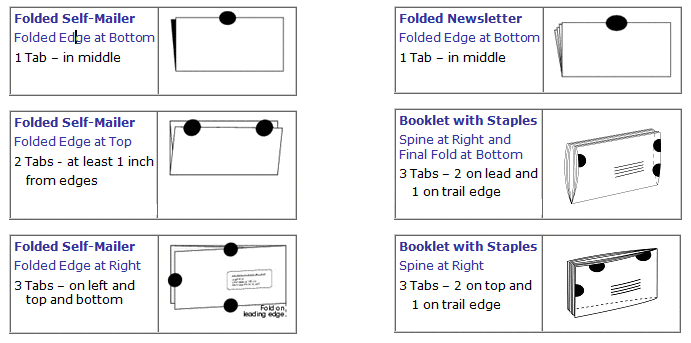In order to quality for Automation rates, all booklets must comply with new U.S. Postal Service regulations. These requirements create a new Booklet class of self-mailers. The regulations include new specifications for booklet size, paper weight and sealing options for machinable, automation letter-size booklets.
Download the USPS Booklet Sealing Requirements
Highlights of the Requirements
First , 1.5″ paper wafer seals must be used instead of the 1″ seals. This affects both how the piece is designed and the mechanics of setting the equipment.
Second, the number of seals (see below) may require multiple passes, which affect both production times and labor costs.
Third, from a practical standpoint no one will be using Mylar/plastic seals anymore. By not allowing perforations, plastic seals just won’t open easily. To avoid pieces from being ripped or torn when opened, translucent or white paper seals will now become the new standard.
Below are the new Booklet class standards and specifications per the Domestic Mail Manual (DMM):
USPS Definition of Booklets
Booklets must have a bound edge. Sheets that are fastened with at least two staples in the manufacturing fold (saddle stitched), perfect bound, pressed-glued, or joined together by another binding method that produces an end where pages are attached together are considered booklets. Booklets are open on three sides before sealing, similar in design to a book. In general, booklets must be uniformly thick. Large bound booklets that are folded for mailing qualify for automation and machinable prices if the final mailpiece remains nearly uniform in thickness.
Minimum and Maximum Dimensions
- Height: 6 inches maximum, 3.5 inches minimum
- Length: 10.5 maximum, 5 inches minimum
- Thickness: 0.25 inch maximum, 0.009 inch minimum
- Weight: Not more than 3 ounces
- Aspect Ratio: Within 1.3 to 2.5
Design and Sealing Tabs (or wafer seals), glue spots, glue lines and tape are acceptable sealing options. Placement varies based on the design of the booklet; the chart below breaks down the options:





